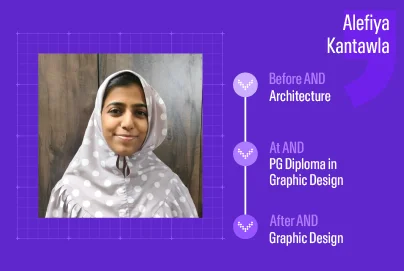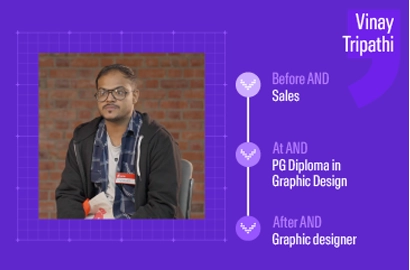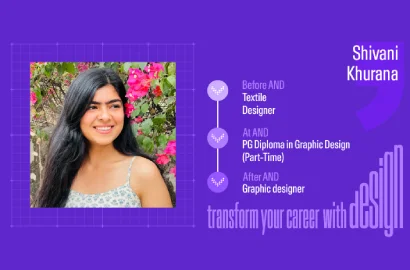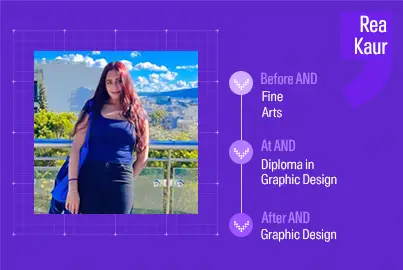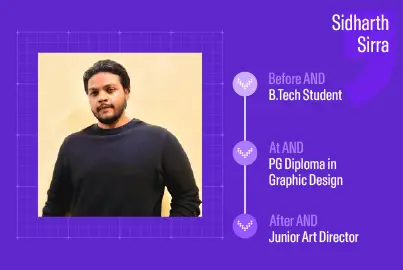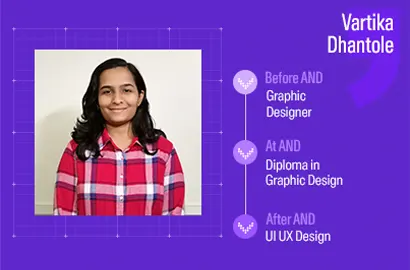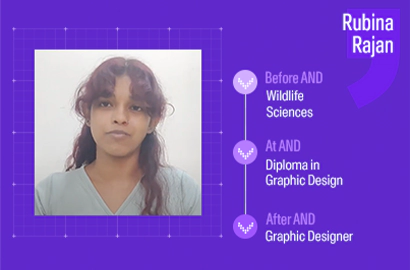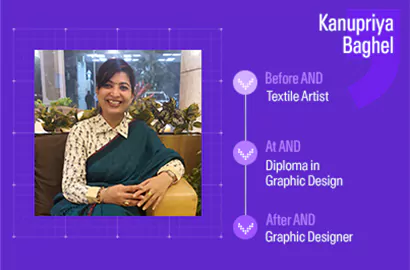In this edition of our student journeys, Rati Rai, a dedicated computer science engineering student, shares her learning journey as she transitions into a graphic designer and gives a thorough walkthrough of her final project.
“Through my work at AND Academy, I learned the importance of research in design. Every project begins with understanding the history, materials, and craftsmanship, and all of this influences the final design. ”
Back with another captivating journey, we are in conversation with Rati Rai, an AND learner who has completed her PG Diploma in Graphic Design with us. Come along as she shares her design process and insights in this fun student interaction.
Here’s an overview of our conversation:
- Rati’s background
- What sparked her interest in design?
- Why did she pursue Graphic Design at AND Academy?
- Walk through of her Print and Publication project
- Design choices and thought process
- Her choice of font & typography for her designs
- Learnings and challenges
- The best three aspects of her experience at AND Academy
- Her career aspirations
- Key ingredients to becoming a designer
- Advice for design learners
- Would she recommend AND Academy to peers?
Let’s begin!
Q1. To start, could you share a bit about yourself and your background?
So, I come from a typical engineering background and graduated with a degree in Computer Science Engineering in 2021, during the COVID period. After that, I immediately joined Tata Consultancy Services (TCS), where I worked for two years as a System Engineer, while simultaneously developing an interest in design.
I’m originally from a small town, Khurai, in Madhya Pradesh, I did my schooling there as well, and I was always an active and sporty person, participating in everything that came my way. I’ve always had a curious nature, which led me to explore various interests and activities. My father is a timber merchant with a furniture business, where he works with raw materials to supply finished products. This process sparked my interest in design, particularly furniture design. Throughout my college journey, I was always drawn to the creative side and actively participated in various events. Being part of these experiences made me realize how much I enjoyed the creative aspect of it all and eventually led me toward graphic design.
That’s great to hear! it’s wonderful to see how your background has shaped your passion for design.
Q2. So, what about design sparked your curiosity and made you want to explore it further?
While working at TCS as a system engineer, I had the opportunity to work on a design project and that experience sparked my interest in graphic design. It also made me realize that I needed to upskill.
Although my curiosity about the field started much earlier. Back in college, probably in my second or third year, I used to volunteer for a lot of events. My friends were involved in designing, and I was always fascinated by how they created these posters and creatives. I often wished I could do that too and was also interested in designing software interfaces.
I also remember when digital planners were trending. I used to love creating them! I enjoyed experimenting with different layouts, designs, and functionalities. I started creating planners on my own using Canva and even sold them on Etsy. This hands-on exploration helped me realize how I could leverage design to create something both functional and visually appealing, something that combines logic and creativity. I experimented with typography, colors, and different themes, constantly pushing the boundaries of what I could create, which eventually led me to dive deeper into design and expand my creative skills.
It is always interesting how creative people can be with their designs.
Q3. What made you pursue a graphic design course from AND Academy and how did you find it?
Curiosity led me to design, and I chose to pursue a Graphic Design course from AND Academy because I wanted to have a solid foundation in design. I realized that a good level of upskilling was required, especially if I wanted to pursue further design education later on. Through my research, I also found that even if I wanted to pursue a master’s degree in design in the future, without a degree or formal qualification in the field, it wouldn’t be possible. So, I knew getting a PG diploma and a thorough understanding of design was crucial.
Although I had taken a few beginner-friendly courses on LinkedIn, I found them lacking in depth and quality. I needed something more comprehensive. I explored a lot of online courses and coaching programs that offered 2-3 month courses, but I was often disappointed by the duration and content. That’s when I came across AND Academy. After reading their brochure, I was impressed by the structure and industry relevance of their curriculum, which seemed to perfectly align with my goals.
At that time, I realized that investing another two years in a traditional degree wasn’t realistic for me, so I decided to join AND Academy. Their ten-month PG Diploma course offered in-depth learning with a comprehensive curriculum. I can confidently say that I’ve learned so much about graphic design thanks to this course. From color theory and typography to the fundamental principles, I now have a strong grasp of the field. Looking back, I remember designing a business card for my father using random fonts, now, with a deeper understanding of typefaces and fonts, it makes me laugh when I think about how I approached it!
Also, at AND Academy, connecting with the managing team was so easy. They took the time to walk me through the process and workshops in detail, starting from scratch and showing me how I could grow to be a designer.
I’m glad AND could help provide direction and support to your design journey.
Q4. Could you walk us through your print and publication project?
Surely. This is from my second module- a print and publication project where I created an invite and brochure for a hypothetical textile event. Before diving into the research and design, one thing I would like to mention is the workshop we attended. It was one of the multiple workshops held at AND Academy to help us learn beyond the regular curriculum. This particular workshop focused on the diverse textiles of India, exploring the unique craftsmanship and culture of various states. It was really valuable as it provided a solid understanding of the textiles and materials we would be working with for the project. The workshop covered everything from the history to the present day, giving us the background we needed to choose clear ideas and decide which type of textile to focus on.
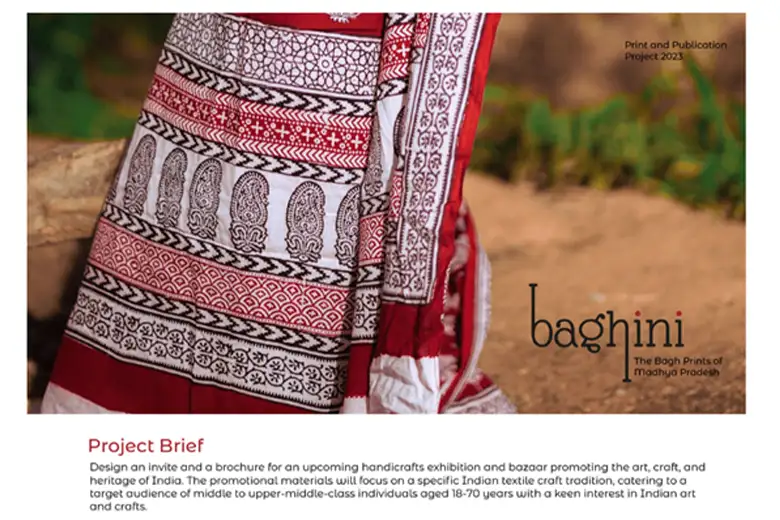
Design Brief for the Project
After gaining insights from the workshop, I chose to focus on Bagh print, a traditional textile art from Madhya Pradesh that I had admired since childhood. Although I had seen these prints many times, I didn’t know their name and never fully understood their significance or the process involved in creating them. This project allowed me to learn about Bagh printing, including its history, craftsmanship, and cultural relevance. Through this process, I realized that research is the most crucial part of the design process, as it lays the foundation for visual exploration and informs design decisions.
I engaged in mind mapping, design inception, ideation, and creating a visual identity. These tools helped me leverage my process and guided me to know what elements to include or exclude. I named the exhibition “Baghini,” reflecting the textile event’s focus. I created motifs and elements that resonated with the prints, using Adobe to develop logos and sketches for the design. After conducting research, I learned about the elements of typography. The folding mechanism I chose involved experimenting with different paper types and techniques to enhance the overall presentation.
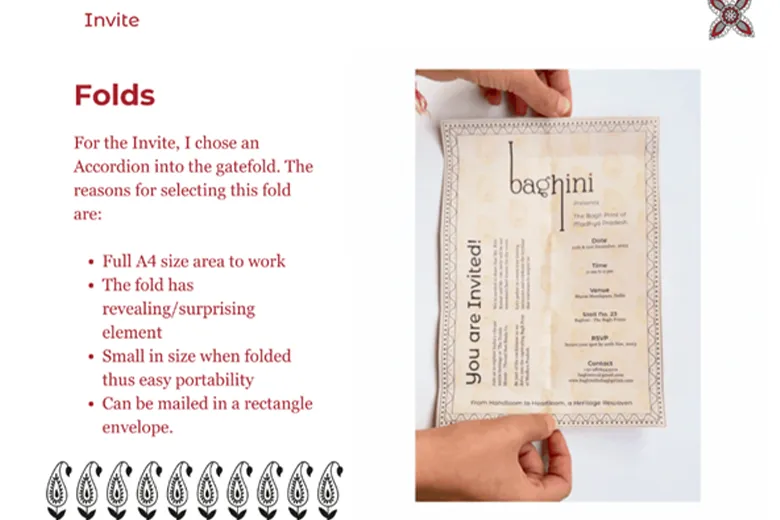
Invite folding structure
For the invite and brochure, we were taught the different folding mechanisms we could use, the types of layouts and prints to consider (especially for print media), the types of materials, styles, and the types of printing involved—especially in packaging. We also learned about different types of machines used for printing.
We explored multiple folds and how we can relate them to different typography and fonts, determining which is best suited for high-fidelity design. Working collaboratively on Miro with mentors was essential for distinguishing between various folding mechanisms and brochure styles while considering costs to ensure the invite’s size was appropriate for printing on A3 or A4 paper. Motifs and creative elements were thoughtfully crafted, beginning with the project’s and publication’s goals in mind. After this, in a detailed session, we tagged the instructor to discuss the feedback we received, based on which we made modifications to our designs.
Each folding mechanism had a specific name. For the brochure, we used step-by-step folds, while the invite has an accordion fold. This differentiation is essential in making design choices that resonate with the intended audience.
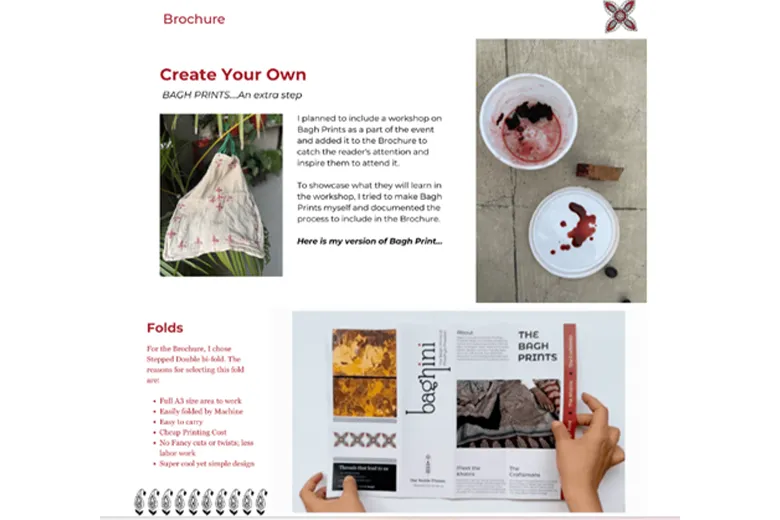
Brochure Folding Structure
Q5. Quite insightful. Now we’d love to hear more about your thought process and inspiration behind the project.
My thought process began with detailed research, which I consider one of the most important aspects of any project. I chose the Bagh print from Madhya Pradesh for my project due to its personal connection and rich cultural significance. Growing up, I admired these prints, and over time, I got to learn more about them. After conducting thorough research into the process and history of Bagh prints, I focused on how to document this information.
Reflecting on my design process for the brochure, I realized that folding mechanisms play a crucial role. Each type of fold serves different purposes and conveys specific meaning and emotion. I considered several factors while designing the brochure and documented my process in detail to be able to apply that understanding to the final work.

Motifs inspired by the traditional Bagh print
One key aspect is recognizing that invites and brochures are two different collaterals. Understanding the financial implications was vital, especially since we learned about various printing mechanisms. This knowledge helped us consider how to minimize costs based on the size of the printed materials. For instance, the A4 invite design is smaller and more compact, while the brochure utilizes a larger A3 size. The choice of material also matters for cost-effectiveness.
Wow! Your project shows how much thought and research went into it. The way you’ve incorporated the cultural significance of the Bagh print into your design is so natural.
Q6. What influenced your particular choice of font or typography for your designs?
Yes, when we are researching any kind of brief, we are given motifs that help us understand the design. For example, in the Bagh print project, you can see the motifs reflect curvy and elegant styles and this directly influences the choice of typography and colors in the design. The prominent colors in Bagh prints are red, white, and black, and these same colors are used in the invite and brochure, though with different fonts and styles.
Similarly, we were taught how to choose different types of fonts to evoke different emotions. Thinner fonts can show elegance, while thicker fonts convey strength. For headings and body text, we used different fonts to differentiate the visual hierarchy and emotional tone. It’s all about research and understanding the emotions that should come through in the design. The key is to give rational reasoning for the choice of color, typography, and design, ensuring that they work together beautifully to give the design a complete look.
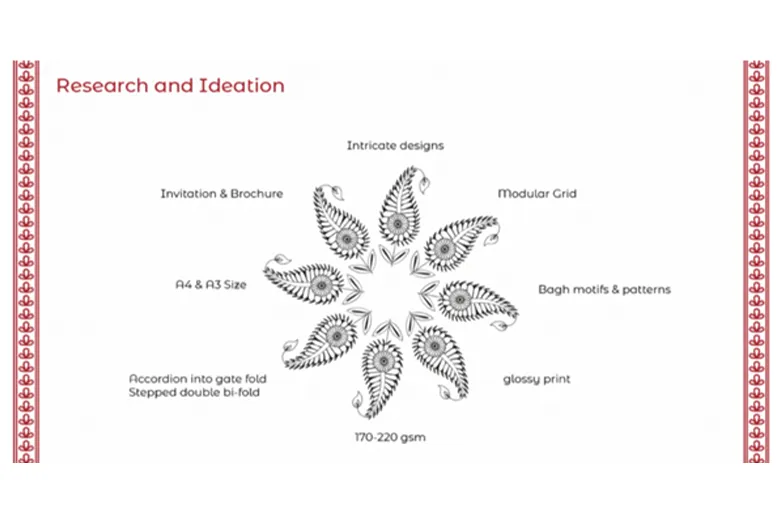
Research and Ideation Process
Your project is so pretty to look at! It perfectly captures the essence of Indian design and makes so much sense even to a non-designer like myself.
Q7. So my next question is, what were your learnings and challenges with this project?
Overall, my learning experience at AND Academy has been incredible. Working on these projects has given me a great perspective on design. For example, when you look at banner designs, posters, and other branding elements, it’s clear that things don’t always match up at first. However, through personal reflection and development, I noticed how I can improve and make rational design choices. Over time, I’ve gained confidence and clarity about why I do what I do, which helps me communicate my thoughts better through my designs.
One key learning for me has been how to condense everything into one comprehensive package. I’m also genuinely happy with my progress. For instance, in a recent logo design project, I redesigned a logo for a brand. The new design included a boat inside a log, which I felt really proud of. This project made me realize how far I’ve come, and it sparked a deep interest in storytelling through design.
Now, when I see other brands’ shop menus, boards, or even digital content, I often think about how I could improve the design—whether it’s the typography, the clarity of the layout, or the color scheme. Every decision I make as a designer has to be rational and intentional, as I’ve learned to think critically about how each element impacts the overall user experience.
It’s great to hear about the progress you’ve made.
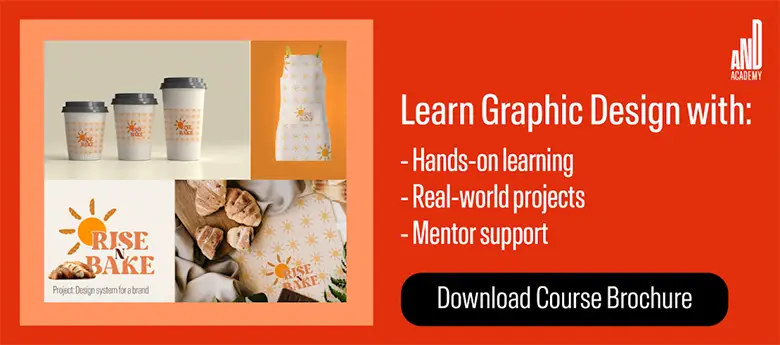
Q8 Now, reflecting on your time at AND Academy, what are three aspects of your experience that stood out to you the most?
For me, the very first thing that stood out was the structure and curriculum and how it’s divided step by step. What we learned earlier is applied in the next term, which makes the learning process well-structured and logical. Everything I’ve learned here feels like it builds on previous knowledge, creating a solid foundation for the next step.
Another aspect I really appreciate is the way Soumaya Ma’am teaches. The way she nurtured us from the start is something I’ll always remember. I recall her saying that we are like seeds that will grow, and she guided us through that process. Her approach was amazing, especially considering the diverse range of students, from 20-year-olds to those who were much older. She seamlessly balanced her teaching style to make sure everyone, regardless of age or background, felt included and could grasp the concepts.
The third thing I’d highlight is the workshops. They were practical and hands-on. We had some amazing sessions, spanning across photography, comic book making, and sketching. Every module came with multiple projects, which sometimes felt hectic but were incredibly rewarding. Every Saturday, we had sessions with Anurag Sir, where I learned so much about angles and photography. These workshops weren’t just informative—they were a high-level experience that deepened my skills and understanding. As we progressed, we had even more advanced workshops, making it a continuous learning journey.
Overall, I’m so happy with how everything turned out. It’s been a journey that has helped me grow both personally and professionally.
It’s great to hear how instrumental AND Academy has been to your growth!
Q9 As you look to the future, what are your career aspirations?
Since I’ve already gained experience working in an MNC, I’m now looking to explore opportunities within startups and smaller design agencies. I believe this shift will allow me to thrive, contribute in unique ways, and gain exposure to the flexibility and creativity that such environments offer. I’m especially excited about working with good design agencies or firms that foster growth and creativity, places where I can continue to evolve as both a designer and a professional.
One of my biggest inspirations is Paula Scher, one of the greatest designers in the world. I aspire to reach a point in my career where I can look back and reflect on a vast range of projects. I don’t want to limit myself to just one area of design. My goal is to explore multimedia and other creative fields, continuously learning and growing in different design niches.
I want to be known for my versatility—working across multiple domains—though I’m aware that being spread across different areas might mean no one truly knows me for just one thing. However, my ambition is to be recognized for the variety of work I do, showing that I’m not confined to a single niche.
Currently, I’ve completed my course and am busy with interviews, refining my portfolio, and creating projects that I can proudly showcase. This is an exciting time as I look for a role that will give me the space to grow. In the long run, I see myself transitioning into freelancing or even starting my own design agency within the next 2 to 3 years. That’s my ultimate goal.
It’s inspiring to see your clear vision for the future, Best of luck on your journey ahead!
Q10. Based on your learning, what would you say are the key ingredients to becoming a great graphic designer?
When it comes to becoming a great graphic designer, the key ingredients are curiosity, exploration, and continuous learning. First, it’s important to ask yourself why something is happening and why you’re doing it. Keep exploring and questioning why things work the way they do, and consider what you can do differently.
Having an open mind and the ability to see things from different perspectives—both your own and others—is essential. Lastly, the ability to keep learning, growing, and adapting as the design industry evolves is crucial. Embrace this journey of continuous improvement, and remember that every challenge you face is an opportunity to grow into the designer you aspire to be.
Great! Thank you for outlining those key ingredients for us.
Q11. What is the one piece of advice you’d give to an AND learner?
To all the future AND learners, I’d say: enjoy every single moment of your time here. It’s truly an experience you’ll treasure forever, and once it’s over, you’ll find yourself missing it. I remember during our graduation ceremony when we were asked about the challenges we faced throughout the program, I realized that the hardest part for me was when the classes ended. I had become so accustomed that it was difficult to sit idle afterward.
So, make the most of every class, project, and moment while you’re here. Dive deep into the learning process, embrace each challenge, and don’t shy away from growth. You won’t regret it. Keep pushing yourself, keep refining your skills, and always seek ways to improve, because everything you learn at AND will build a strong foundation for your future success.
It’s clear that you’ve made the most of your time at AND Academy.
Q12 Would you recommend AND Academy courses to your friends and family?
Yes, I already have! I recommended the diploma course to one of my friends who was exploring design courses. I believe that the diploma program at AND is great for anyone looking to build a foundation in graphic design. It combines theory with hands-on practice and I would highly recommend it to my friends and family.
It’s wonderful to hear that you’re already recommending AND Academy to others! Thanks a lot for speaking with us.
Has Rati’s inspiring journey ignited the designer within you too? If so, follow her footsteps and become a skilled graphic designer with AND’s Graphic Design Certificate Course today. If you are an experienced designer looking to upskill, you can also consider the Diploma or PG Diploma course in Graphic Design.
For further details, speak to our Course Advisors today!
Note: All information and/or data from external sources is believed to be accurate as of the date of publication.


